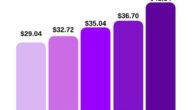The fashion industry has long been associated with glamour, creativity, and luxury. But behind the glitz and glamour, there is a complex web of factors that influence the salaries of fashion professionals. In this blog post, we will explore the highs and lows of a career in the fashion industry, delving into the various factors that shape salary levels, trends in the industry, and the top-paying jobs. From entry-level salaries to negotiating tips for seasoned professionals, we’ll uncover the intricacies of fashion industry compensation. Additionally, we’ll examine the gender pay gap, the impact of location on salaries, and the economic challenges that affect the earning potential of fashion professionals. Whether you’re considering a career in the fashion industry or are already a part of it, understanding the nuances of fashion industry salaries and how they measure up against the cost of living is crucial for making informed career decisions. So, let’s dive into the world of fashion industry salaries and shed light on this fascinating, yet often overlooked, aspect of the industry.
Table of Contents
Introduction to Fashion Industry Salaries
When considering a career in the fashion industry, it is important to have a clear understanding of the potential earning opportunities. Salaries in the fashion industry can vary widely depending on various factors, including job role, location, and experience level.
Fashion industry salaries can be influenced by the specific sector of the industry in which an individual works. For example, salaries in fashion design may differ from those in retail management or marketing.
Additionally, the level of experience and education can also have a significant impact on fashion industry salaries. Entry-level positions in the industry may offer lower salaries compared to more senior roles, which require years of experience and expertise.
Understanding the various factors that influence fashion industry salaries can help individuals make informed decisions about their career paths and the potential earning opportunities within the industry.
Factors that Influence Fashion Industry Salaries
Factors that Influence Fashion Industry Salaries
There are several factors that can influence salaries in the fashion industry. One of the most significant factors is the level of education and experience a person has in the field. Those with a higher level of education and more years of experience are likely to earn a higher salary. Additionally, the type of job within the fashion industry can also greatly impact salary. For example, those in management positions or in roles that require specialized skills, such as design or technology, may earn a higher salary compared to entry-level positions.
Another factor that can influence fashion industry salaries is the location of the job. Salaries can vary greatly depending on the city or region in which a fashion professional is employed. For example, a fashion designer in a major fashion hub like New York City may earn a higher salary compared to a designer working in a smaller city or rural area.
Furthermore, the size and reputation of the company or organization can also play a role in determining fashion industry salaries. Large, well-established companies may have more resources to offer higher salaries compared to smaller, start-up companies. Additionally, the economic conditions of the fashion industry as a whole can also impact salaries. In times of economic prosperity, fashion professionals may see an increase in their salaries, while during economic downturns, salaries may be stagnant or even decrease.
It is important for individuals in the fashion industry to be aware of these factors that can influence their salaries, and to consider them when making career decisions or negotiating for higher pay.
Trends in Fashion Industry Salaries
When it comes to fashion industry salaries, there are several trends that professionals in the field need to be aware of. One major trend is the increasing focus on sustainability and ethical practices within the industry. As consumers become more conscious of the environmental and social impact of the fashion industry, companies are investing in sustainable practices and ethical sourcing, which can impact the salaries of professionals involved in these efforts.
Another trend in fashion industry salaries is the growing influence of technology. With the rise of e-commerce and digital marketing, professionals with skills in areas such as data analysis and digital strategy are in high demand, leading to competitive salaries in these segments of the industry.
Furthermore, the globalization of the fashion industry has also impacted salaries. As more companies expand their operations internationally, professionals with expertise in global market trends and cross-cultural communication are seeing increased compensation opportunities.
Finally, the emergence of direct-to-consumer brands and the rise of influencer marketing have also shifted the landscape of fashion industry salaries. As these trends continue to evolve, professionals can expect to see changes in the demand for certain skill sets and the corresponding impact on salaries within the industry.
Top-Paying Jobs in the Fashion Industry
When it comes to the fashion industry, there are a number of lucrative job opportunities that offer competitive salaries. These jobs not only provide financial stability but also allow individuals to work in a creative and dynamic environment.
One of the top-paying jobs in the fashion industry is that of a fashion designer. Fashion designers are responsible for creating original clothing, accessories, and footwear. They not only need to have a strong sense of style and creativity but also have to understand the technical aspects of garment production. The median salary for fashion designers is $73,790 per year, with the highest 10 percent earning more than $146,300 annually.
Another high-paying job within the fashion industry is that of a fashion marketing manager. These professionals are responsible for creating and implementing marketing strategies to promote fashion brands and products. They work closely with advertising agencies, public relations firms, and media outlets to create compelling campaigns. The median salary for fashion marketing managers is $132,620 per year, with the top earners making over $208,000 annually.
Additionally, fashion merchandising directors are also among the top-paying jobs within the industry. These individuals are responsible for planning and coordinating the buying and selling of fashion products. They analyze market trends, conduct research, and work closely with manufacturers and retailers to maximize profits. The median salary for fashion merchandising directors is $124,240 per year, with the potential to earn over $208,000 annually.
Entry-Level Salaries in Fashion
Entry-level salaries in the fashion industry can vary widely depending on several factors, including the specific role, the company, and the location. Individuals entering the fashion industry for the first time often have to navigate these varying salaries as they begin their careers.
It is important for those seeking entry-level positions in fashion to research salary ranges for their desired roles and locations. Understanding the average salary for a particular position can help individuals negotiate their starting pay and ensure they are being fairly compensated for their work.
While entry-level salaries in fashion may not be as high as more experienced professionals, there are still opportunities for growth and advancement within the industry. Many entry-level positions serve as a stepping stone for individuals to gain valuable experience and skills that can lead to higher-paying roles in the future.
Overall, entry-level salaries in the fashion industry should be seen as the starting point in a career path rather than a permanent salary. By staying informed about industry trends and networking with professionals, individuals can position themselves for continued success and increased earning potential in the fashion industry.
Salary Negotiation Tips for Fashion Professionals
When it comes to negotiating salaries in the fashion industry, there are several tips and strategies that professionals can utilize to ensure they are fairly compensated for their work.
One important tip is to research the average salary for the specific role and experience level within the industry. This information can provide leverage when discussing compensation with a potential employer. It is also crucial to highlight any relevant skills, experience, and accomplishments that justify a higher salary.
Another tip is to approach the negotiation process with confidence and professionalism. This can be achieved by practicing and role-playing the negotiation conversation beforehand. Additionally, it is important to clearly articulate the value that the individual brings to the company and how their contributions will positively impact the bottom line.
Furthermore, it is essential to be open to other forms of compensation, such as bonuses, benefits, or flexible work arrangements. These alternatives can add to the overall compensation package and make the offer more attractive.
Gender Pay Gap in the Fashion Industry
One of the pressing issues in the fashion industry is the gender pay gap. Despite the progress made towards gender equality in the workplace, women in the fashion industry continue to earn less than their male counterparts. This wage disparity is a result of various factors that contribute to the overall gender pay gap in society.
Historically, the fashion industry has been male-dominated, with men holding the majority of leadership and high-paying positions. This lack of gender diversity in senior roles has perpetuated unequal pay practices and hindered women’s career advancement opportunities. Additionally, stereotypes and unconscious biases about women’s skills and abilities in the workplace have further contributed to the gender pay gap in the fashion industry.
Another factor that influences the gender pay gap in fashion is the discrepancy in negotiating salaries and promotions. Studies have shown that women are less likely to negotiate their salaries compared to men, leading to lower starting salaries and fewer opportunities for career advancement. As a result, women in the fashion industry often find themselves earning significantly less than their male counterparts, even when performing similar roles and responsibilities.
Addressing the gender pay gap in the fashion industry requires a concerted effort from both employers and employees. Implementing transparent pay policies, providing equal opportunities for career growth, and promoting gender diversity in leadership positions are crucial steps towards closing the gender pay gap and creating a more equitable work environment for all fashion professionals.
Impact of Location on Fashion Industry Salaries
One of the key factors that influence fashion industry salaries is the location of the job. The cost of living and demand for fashion professionals varies greatly from city to city, and this has a direct impact on how much individuals are compensated for their work.
For example, cities like New York, Los Angeles, and Paris are known for being major fashion capitals, and as a result, professionals working in these locations tend to command higher salaries compared to those in smaller, less competitive markets. This is largely due to the higher demand for talent and the increased cost of living in these metropolitan areas.
On the other hand, fashion professionals working in smaller cities or towns, where the demand for their expertise may be lower and the cost of living is more affordable, may find that their salaries are not as competitive as their counterparts in major fashion hubs. However, it’s important to consider that while the cost of living may be lower in these locations, so too might be the opportunities for career advancement and professional growth.
Ultimately, the location of a fashion job plays a significant role in determining salaries and compensation packages. As such, for individuals considering a career in the fashion industry, it’s crucial to carefully weigh the potential financial implications of working in different locations and to consider how these factors align with their personal and professional goals.
Fashion Industry Salaries vs. Cost of Living
When considering a career in the fashion industry, it’s important to weigh the potential salary against the cost of living in different locations. The fashion industry is known for offering a wide range of salaries, so understanding how those salaries compare to the cost of living is crucial for making informed decisions about where to live and work.
Cost of living can vary drastically from city to city, and even from neighborhood to neighborhood within the same city. In fashion capitals like New York, Los Angeles, and Paris, the cost of living tends to be higher due to the demand for housing, transportation, and other necessities. On the other hand, smaller cities and towns may offer a more affordable cost of living, but also tend to have lower average fashion industry salaries.
It’s important for industry professionals to consider how their earning potential aligns with the cost of living in their desired location. For example, while a job in New York City may offer a higher salary, the cost of living may offset those earnings, leading to a potentially lower overall quality of life. Conversely, a job in a smaller, less expensive city may offer a lower salary, but the lower cost of living may result in a higher standard of living.
Ultimately, the relationship between fashion industry salaries and cost of living is a complex and individualized consideration that depends on a variety of factors, including personal preferences, career goals, and financial priorities. By carefully evaluating these factors, fashion professionals can make informed decisions about where to live and work in order to achieve a satisfying balance between their earnings and cost of living expenses.
Economic Challenges Affecting Fashion Industry Salaries
In today’s global economy, the fashion industry is facing numerous economic challenges that are directly impacting salaries for professionals in the field. One of the main economic challenges affecting fashion industry salaries is the increasing cost of production. With rising labor and material costs, companies are forced to cut costs elsewhere, often resulting in lower salaries for employees.
Another economic challenge is the fluctuating consumer demand. In a volatile market, companies may experience unpredictable sales trends, leading to uncertainty in revenue and budgeting. This can directly affect the ability to offer competitive salaries to fashion industry professionals.
Furthermore, the impact of globalization on the fashion industry cannot be ignored. As companies expand their operations globally, they must navigate diverse market conditions, trade policies, and currency exchange rates. These factors can create additional economic challenges that directly influence the salaries of professionals in the fashion industry.
Lastly, the ongoing economic recession and financial instability in some regions can have a significant impact on fashion industry salaries. When consumer spending decreases, companies may struggle to maintain steady profits, often resulting in salary freezes or reductions for employees.






